Edward J. Branley's Blog: Eloquent Profanity, page 8
November 21, 2019
Upcoming Adventures – Talks and Signings
Upcoming adventures – Edward’s talks and signings.

Upcoming Adventures
A few engagements coming up, stop by and check them out!
Friday, November 22 (TOMORROW)
Personal Websites for Authors

9:00am
Ace Hotel, 600 Carondelet Street, New Orleans
Workshop. $10. Ticket price includes continental breakfast.
Local writer and self-described computer nerd Edward Branley will guide writers through the fundamentals of building a website to increase their visibility and marketing. Topics include website content, writing bios for different platforms, and more!
A part of Words & Music: A Literary Feast in New Orleans.
Tuesday, December 10th

The Golden Age of Canal Street
Reception – 6:30pm – 7pm
Talk begins at 7pm.
Nunez Community College- Auditorium
3710 Paris Road
Chalmette, LA 70043
I’ll have books for sale!
Friday, December, 13th
Book Signing at Walgreens

image courtesy Commons user “MusikAnimal”
Book Signing at Walgreens, 900 Canal Street, 3pm-5pm.
I’ll be signing New Orleans: The Canal Streetcar Line, and New Orleans Jazz. There’s even a photo of this Walgreens, from 1939, in the streetcar book!
Mark your calendars!
The post Upcoming Adventures – Talks and Signings appeared first on Edward J. Branley.
October 5, 2019
Notebooks Fountain Pens and BuJo strategy
Notebooks fountain pens and updating my Bujo strategy
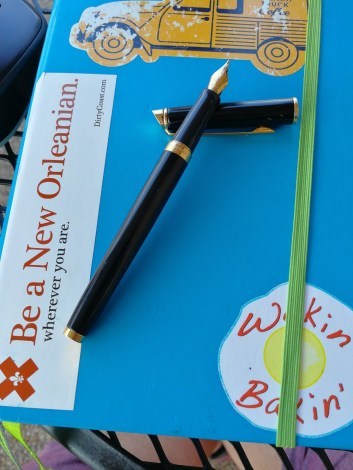
My most expensive pen, a hundred-dollar Waterman, on top of my current BuJo notebook.
Notebooks, fountain pens
I was in Manhattan back in the spring, teaching a class for Hitachi Global Learning. When I’m on the road, I prefer taking my backpack rather than the messenger bag I take to coffee shops when I’m home. When packing for the trip, this desire adds a step, shifting stuff from the “home” bag to the “travel” bag. I’m usually pretty good about this, but this particular trip, I forgot something. I left my current Bullet Journal notebook (BuJo) in the messenger bag! Not to worry, there’s a Staples on 5th Avenue around 38th or 39th. So, I picked up a Moleskine and kept on going.
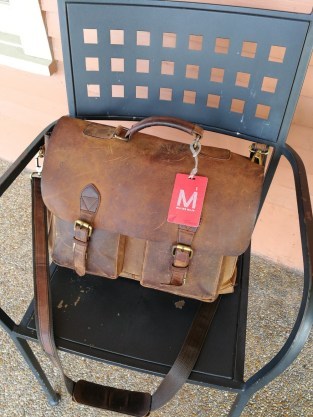
My “around town” messenger bag.
I filled up that notebook this week. Therefore, I’m going back to the one I left at home. So, now I’m back to a Leuchturm1917 brand notebook. I forgot that I really like the quality of the Leuchturm1917 when compared to the Moleskine. Now, please understand, I’m not saying the Moleskine is bad, just that the Leuchturm1917 feels better.
Cheap vs. Pricey
There’s another complication/issue with the German notebooks. While the paper is good quality, it’s thinner than the Moleskine. My love of notebooks, fountain pens is the complication. Most of the inexpensive fountain pens I use have medium-point nibs. The ink flow is a bit heavy. This was more of an issue when all I used to write in the BuJo were the pens. Now that I make my weekly planner page and daily headers with my “adult coloring” set of Prismacolor pencils, all I write in ink is the detail stuff.
So, that means I have to do something I haven’t done regularly. I carry my most expensive fountain pen with me. It’s a Waterman I bought for about a hundred bucks a few years back. My other pens are under-$10 items I buy off eBay. If I wear them out or lose one, well, I don’t shed many tears. I still may leave the Waterman home when I travel and just let notebooks, fountain pens bleed in Ohio.
The post Notebooks Fountain Pens and BuJo strategy appeared first on Edward J. Branley.
July 20, 2019
Jeff Parish Library Workshop – Author Websites
Jeff Parish Library Workshop, just before the meeting of the RWA chapter

Jeff Parish Library Workshop
I had the privilege of speaking at the Jefferson Parish Public Library (East Bank Regional Branch) this morning. This Jeff Parish Library workshop was titled, The Importance of Author Websites.
Author Websites
The top-level topics of the talk:
What is your goal? – you need to have an idea of where you’re going with this.
Domain names and hosting – get YourName dot com at a minimum.
Content Management with WordPress – It’s the easiest way to do this.
Design – logos, banners, book covers, images/art, specific fonts
Content – write! fire up the blogging!
eCommerce – It’s OK to punt sales to Amazon and your publisher. There are ways to sell your own stuff (books and book-related merchandise) from a WordPress site.
Connections – Start everything from your blog. Syndicate your blog to Amazon Author’s page and your Goodreads author page. Push your blog posts out to Twitter, Facebook, LinkedIn, Tumblr
Personal Networking – promote your friends who are writers, as well as local booksellers, podcasters, and others.
Search Engines – spread the word about your blog.
Have Fun!
We went a bit over the time Chris set for us, but the group had fun, and that’s what it’s all about.
Powerpoint
You can download the PPT file of the presentation here. This was a good talk, so we’ll likely jump off into some specific blog posts about this stuff. If anyone wants to discuss something in detail, find me on Facebook, or email me.
Facebook live
We did the “live” thing again today. I’ve got it sorted out now. You can click through and watch the entire presentation on my Edward Branley’s Author Page on the Book of Zucker. I don’t know which of Facebook and YouTube is the “lesser evil,” but I’m good with using Facebook Live for now. Fewer crazies and such there. YouTube is such a sewer.
Wallpaper
Several folks asked after the wallpaper on my computer. Here’s the story.
The post Jeff Parish Library Workshop – Author Websites appeared first on Edward J. Branley.
July 9, 2019
BuJo Weekly Layout – (Bullet Journaling Part 2)
How I use my BuJo Weekly Layout (Part 2 of Bullet Journaling)
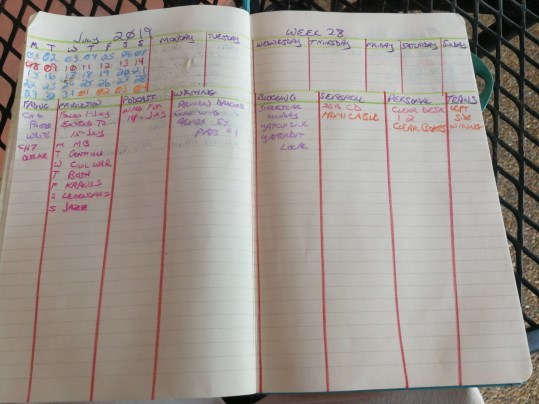
BuJo: my weekly layout format
BuJo Weekly Layout
In Part 1, y’all learned how I came to BuJo as a time management/organization system. “Minimalist” characterizes my approach. At first, I started the ABC/123 of Franklin-Covey, but gave up on it quickly. I wanted a to-do list. I wanted to prioritize it. If I didn’t sit down and set it up one day, I didn’t want my planner to shame me. BuJo gets me.
Thinking Weekly
A comfortable place for a daily to-do was a great start. Then I followed some of the BuJo groups on the Book of Zucker. Many members of these groups possess much more artistic ability than I. Their work challenged me to “do more” with my BuJo. I’m not the type to embellish my BuJo with drawings in the margins, etc. I do like color, though. So, I looked at layouts and spreads and templates.
Then my friend Grey posted a pic of her weekly template. I fell in love with it immediately. It offered structure and coordination beyond a daily list. Here’s the breakdown.
Monthly Calendar
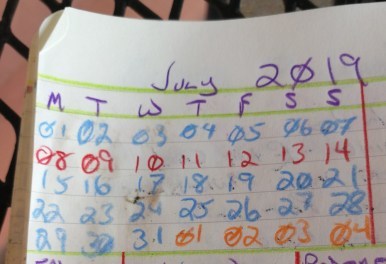
Monthly calendar
I start the week on Monday, in the BuJo and on Gcal. I like to indicate the week of the year, because my European colleagues regularly refer to “Week X” or “Week Y” when discussing projects and milestones.
Color appeared in my monthly calendar early. I usually have four pens in my bag, with blue, black, purple, and red ink. Sometimes the blue gets switched out for green. The calendar contained up to four colors: current month dates (black), current week dates (red), previous month (blue or green), next month (purple). This was before the Prismacolor set.
Weekly Schedule
Essentially traditional, Monday to Sunday. The idea here is to force me to sync up Gcal with the BuJo on a Monday morning. BuJo notes transform into Gcal events/appointments. The engagement starts on the BuJo, since it’s easy to jot something down. Note on daily becomes item on next week becomes Gcal.
Master Task List
One of the features of the Franklin-Covey system I’ve always appreciated is the “Master Task List.” The F-C idea is, you put down all your tasks/to-dos. Then you designate them A-B-C, and prioritize within those larger designations.
We kick tasks down the road. When we do, they fall to “C”, and low in that pecking order. F-C recognizes this. After kicking the can a few days, the task moves to the “master task list.” When you have fewer tasks on a particular day, pick up something from the master list.
The sections at the bottom of the weekly layout are a take on the Master Task List. Some of the items are time-sensitive (podcast production, for example). They receive a “M” or other day notation. Others are flexible. I might not right something for a particular project on Monday. Then Tuesday becomes a hot mess. The writing moves to Wednesday. Maybe. Things move to next week if they’re not done. I should expand this to a master task list at some point.
Color

Daily page from my BuJo
As mentioned earlier, the early BuJo presented in monochrome. I wrote a day/date in black, then to-dos kept going. Red joined in as emphasis for scheduled items and important tasks. Then tasks morphed into purple, notes later in the day in black.
Enter my Prismacolor pencil set. I occasionally color, part of the “adult coloring” fad. I extended that to the BuJo. Color is pure whimsy. Date numbers for the current week still appear in a shade of read, for the most part. Otherwise, it’s whatever mood strikes me!
Is BuJo right for you?
Give it a try for a week. Buy the book, if you’re inspired. Check out some of the Zuckerd00d groups. Let’s talk about it all!
The post BuJo Weekly Layout – (Bullet Journaling Part 2) appeared first on Edward J. Branley.
July 8, 2019
Bullet Journaling – weekly layout – part 1
Staying flexible with bullet journaling
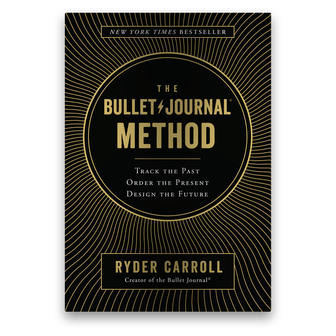
Ryder Carroll’s book
Bullet Journaling
I make attempts to keep organized. For the last couple of years, those attempts revolve around using a “bullet journal.” Bullet Journaling got its name and start from a blogger, Ryder Carroll. Carroll turned the concept into a book, The Bullet Journal Method.
How I came to BuJo
I’ve used a number of different systems, programs, websites, and apps for task and time management over the years. The one thing I got very serious (and consistent in its use) was the Franklin-Covey Method, using their Day Planners. Back in the late 1980s, I had the privilege of doing contract work at a local office of an oil/gas company. Their HR department brought in a Franklin Institute trainer to do a couple of professional development seminars. I was invited to attend. I bought into the Franklin Day Planner hook, line, and sinker, and used it for about fifteen years.
Reconciling paper and electronic
This was a huge challenge for me. I liked my Franklin Day Planner, but the company focused most of their electronic offerings and effort on add-ins for Microsoft Outlook. Since I use Linux more than I do Windows, this presented problems. I needed something to work on my Linux desktop. A number of companies offer open source planning/scheduling/task applications. Franklin-Covey created the “ABC/123” and combined it with the “7 Habits” philosophy. These are proprietary. So, using something that wasn’t Franklin-Covey created gaps.
Locked into the system
I’m not as organized as I could be. My day planner often had blanks for a week at a time. The Franklin-Covey systems offer the pre-printed packs, six months or a year at a time. But what if you need two or three pages for a single day? They offer blank pages, some even matching the pretty theme (I loved “Monticello”) you used in your binder.All that added up to some righteous dollars.
Something more flexible
Between the cost of “filler” packs, “expansion” pages, and subscriptions to on-line services, using Franklin-Covey becomes a commitment. That’s all fine and dandy, until you look at your binder and all those empty pages for the last two weeks. So, I drifted away from the company. Other apps offered to-do list function. Some even had web-based and mobile versions. This was good, right up until the app company got bought out by somebody bigger.
Enter Bullet Journaling (BuJo)
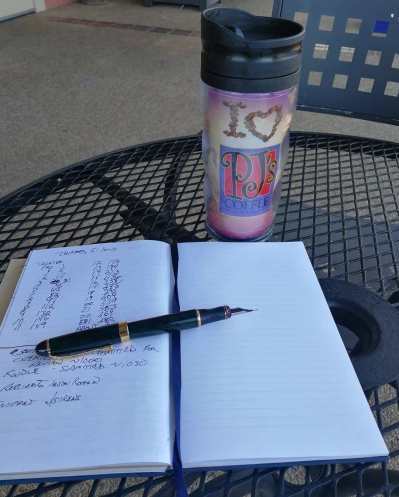
“Minimalist” in a basic notebook
That’s where Bullet Journaling (BuJo) came in. I learned of the concept from the lovely and talented Lady Duchess of the Red Pen, Dara Rochlin. Dara is a list-maker. When we’re in the midst of a writing project (she edits my books), I’m on multiple lists. Bullet Journaling offered Dara a method to organize her prolific lists. It didn’t do all that much for me, at first. I mourned the loss of my “ABC/123” structure.
Adapting BuJo
I discovered that BuJo isn’t a “system” like Franklin-Covey, or Outlook, or any other commercial product. The primary principle of BuJo is that you can use any sort of notebook. You’ve sunk money into a Franklin-Covey binder? Buy blank pages that fit it and BuJo on them. You like basic, student, spiral notebooks? Do that. I like the Moleskine style notebooks. I use them for writing projects. An excuse to buy another notebook? I’m there.
So, I dedicated a Moleskine as a replacement for my day planner. At first, I didn’t do anything fancy, just put the date/day on the top of a page, list to-dos, then add notes on how things worked out. Phone call? Text? Note it below the to-do. Need more space? Keep going to the next page. Writing snippet? put it in the BuJo. Sometimes I’ll just take a pic of the snippet and post it to Instagram.
Expanding the concept
Dara found a number of Facebook groups where people share BuJo ideas. I looked into them. The “minimalist” concepts and designs offered me what I wanted. When my friend Grey posted a photo of her weekly planner layout, I was hooked. We’ll go into that layout in Part 2.
The post Bullet Journaling – weekly layout – part 1 appeared first on Edward J. Branley.
July 2, 2019
Pincord Dresses – Summer Fashion
Pincord dresses are classic New Orleans Summer

Elizabeth McKay Harriet Dress in Navy and White Pincord – Country Club Prep
Pincord Dresses
Every spring, there comes a warm day when Southern gentlemen and women head to the closet and pull out something seersucker. While Seersucker is considered classic “Old South”, I personally prefer pincord. There’s something about a pincord dress or suit that feels more New Orleans to me.
Pincord and the Uptown Girl
Brooks Stirling Sumner, “Silver” to her friends, is one of my characters in Trusted Talents, the second novel in the “Bayou Talents” series. Silver’s story is a fascinating one, and suffice to say, she’ll figure prominently as the series goes forward. Silver is a 28yo former queen of one of the “old-line” Carnival krewes. She comes from money and privilege.
Silver is a running-yoga-pilates person, She cycles when she can, leaving the car in the garage of her condo building. Her wardrobe is, for the most part, classic Preppy. So, pincord in the closet makes sense. Classic preppy pleases her mum and grand-mama. Silver’s wild streak conflicts with their ideas, however. Therefore, her pincord dress climbs up the knee. Mum thought she outgrew that stage after graduating from the Academy of the Sacred Heart, but Pilates creates nice legs!
Footwear
Last week, I threw out a question to my Zuckerd00d friends: do you prefer flip flops or sandals with a back? The responses were mixed. The big knock on flips was the sound of the shoe hitting the foot.
It surprised me that there were no remarks about driving in flip-flops. In the UK, most women opt for sandals with a back, lest the flip get tangled with the pedals when driving. Not a consideration in last week’s thread.
So, I’m still unsure about footwear for Silver and her pincord dress. Flips? Maybe when going someplace very casual, like meeting friends for happy hour. Maybe a nicer sandal for a date. Possibly a wedge to boost height.
I’ll try a basic scene and see what happens.

That’s silver on the left
The post Pincord Dresses – Summer Fashion appeared first on Edward J. Branley.
May 15, 2019
Revisiting Practical Armor for Fighting Women
Revisiting Practical Armor, both Medieval and Futuristic.

Valhallan Nebula
Revisiting Practical Armor
I came across an interesting piece on Teh Tumblrz last week. It’s called Valhallan Nebula. The source is, lightresist.tumblr.com. I’ve been interested in “practical armor” for a couple of years, after submitting a story on the subject to an anthology. The story didn’t get accepted, but my interest in the concept didn’t diminish.
“Bikini Armor” vs the practical sort
One of the most-used forms of “fan service” in fantasy fiction is “bikini armor”. Basically, put a woman in a bikini that’s plated with metal. Yes, if you poke a spear at her breasts or crotch, the metal protects those areas. Why bother, though? Just poke the spear at her thigh, let her bleed out from the femoral artery.
Of course, it’s about fan service. Nobody expects that woman to go into battle. She magically avoids thigh-poking when she does. She exists as an object of desire.
Practical Armor Problems
Women wore dresses in medieval times. They rarely wore pants, much less any sort of protective clothing. Expectations were different for them. Men fought, women maintained the household/homestead. Yes, there were exceptions, such as Joan of Arc. Remember what happened to her, though? So, the concept is problematic. Not much out there to go on.
Problematic doesn’t mean impossible, though. So, thinking through women taking up arms, protecting themselves like the men do, is interesting. Women fight well. They train hard. They prove themselves in modern forces daily. Given the opportunity in medieval times, they would have done the same. So, let’s consider that. Women want protection from battlefield threats. In modern times, that means flak jackets, helmets, good boots. Armies adapt equipment to support women. Suits of armor could have fit women, too.
Futuristic Armor
Future armor will fit women. So, why do artists insist on fan service? In this piece, the woman’s breasts don’t have to be advertised as they are. The entire chest area should be dark, non-reflective, and protective.
Patreon Story!
I’m releasing that story I wrote for the anthology as Patreon content. Got a dollar a month? Sign up and enjoy!
The post Revisiting Practical Armor for Fighting Women appeared first on Edward J. Branley.
May 6, 2019
“For Those Who Celebrate” is a phrase I don’t care for
 To unlock this content, pledge $1 or more on Patreon[image error] Unlock with Patreon
To unlock this content, pledge $1 or more on Patreon[image error] Unlock with PatreonThe post “For Those Who Celebrate” is a phrase I don’t care for appeared first on Edward J. Branley.
May 1, 2019
Screen Porch Houses harken back to before a/c
If you didn’t have air-condition or a lot of fans, you might have lived in screen porch houses growing up.
(cross-posted to NOLA History Guy)

House with a screen porch on Iberville Street in #NOLAMidCity
Screen porch houses
Before central air-conditioning became part of everyday home life, screen porch houses lined the blocks of New Orleans neighborhoods. Residents escaped the heat of summer by going outside. There were two problems with being directly outside, though. First, most folks avoided direct sunlight and sunburn. Second, the mosquitoes! So, homeowners screened in their front porches. Screens allowed the breeze in, but not the bugs. The offered protection from the sun. The wood floor gave the rocking chair a smooth surface.
Nothing to fans to a/c
It’s hard to remember a time before so many homes in New Orleans had air-conditioning. By 2011, 88% of homes in the United States were built with central a/c. Prior to the suburban expansions of the late 1960s/early 1970s, homes lacked a/c. While many were retro-fitted with wall units in bedrooms, living spaces often were not. Families believed you should go outside. Sit on the porch. Talk to the neighbors. Many a writer and literary critic supports the notion that central air conditioning dramatically changed the genre of “Southern Literature”, because people just didn’t socialize like they used to. They holed up inside and stayed cool.
There’s a lot of merit to this concept, In New Orleans, we sit outside for a few weeks in the Spring and the Fall. The rainy season (what the northern parts of the US call, “Winter”) just doesn’t accommodate outside activity. The humidity of the Summer and early Fall drain us.
New Orleans homes
Not everyone has a Spanish Colonial courtyard to retreat to on a hot day. Shotgun homes offer good airflow, but privacy concerns often outweigh the breeze running through the house. That leaves the backyard. Thing is, the backyard isolates the family from the neighborhood. Porch-sitting brings folks together.
The post Screen Porch Houses harken back to before a/c appeared first on Edward J. Branley.
April 30, 2019
Porsche 914 in Hidden Talents
Fr. Michael O’Donnell drives a Porsche 914 in the Talents Universe.

1971 Porsche 914 advertisement
Porsche 914
Porsche introduced the 914 model in 1969. The automaker partnered with Volkswagen on the 914. Porsche wanted an upgrade/update to their model 912. Volkswagen wanted something new to replace their Karmann Ghia. Production of the 914 ran from its introduction until 1976.
The Karmann Ghia
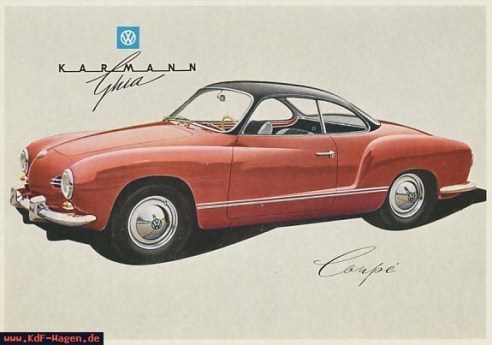
Karmann Ghia
Volkswagen introduced their Karmann Ghia coupe in 1955. They sought an update by the late 1960s. While their partnership with Porsche produced the 914 in 1969, Volkswagen continued production of the Karmann Ghia through 1974. Therefore, VW had (sort of) two coups in the 1970s
Personal experiences
I never rode in a Karmann Ghia, but my dad owned one for a brief time before I was born. So, he would see them go by later on and express his fondness for the sports car of his younger days. By the time I attended university, the Karmann Ghias were old news. They appealed to guys with an interest in older cars, but my friends with 2-seat sports cars opted for the Porsche, or the MGB. One friend even drove an Alfa Romeo
I had two direct encounters with the Porsche 914. The first was in my second and third years as an undergrad at University of New Orleans. A Student Government Association friend owned one. It was a fun little car. The center engine design took a bit of getting used to. As a kid, I found my dad’s rear-engine Beetle a curiosity. The vibration of the center-engine gave the 914 a different feel.
My second 914 encounter was as a student teacher in my fourth year at UNO. My supervising teacher at F. W. Gregory Junior High drove a Porsche 914. While I never got to drive either of those cars, the design, and the fun of riding in my friend’s car stayed with me.
After UNO, I bought a 1980 Plymouth Horizon, to get me to and from Redeemer High School. By all accounts, the Volkswagen transmission in that car behaved much like that of the Porsche 914.
Talents
Mike O’Donnell is a History professor. So, he naturally has an appreciation for older automobiles. While not an auto-repair type himself, Mike picked up the basic skills one needs when one owns an old car. He learned early on in his ownership of a 914 to network with people who can fix your old car. Mike’s Porsche 914 is white in Hidden Talents and Trusted Talents.
The Ad
This ad is from 1971. So, it’s a good representation of Mike’s car. I follow a number of folks on Tumblr who enjoy sharing older/vintage advertising. So, this one made me smile.
The post Porsche 914 in Hidden Talents appeared first on Edward J. Branley.
Eloquent Profanity
- Edward J. Branley's profile
- 46 followers



